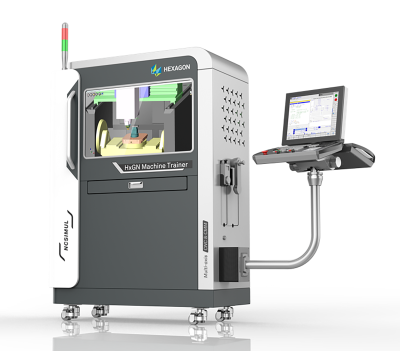
Hexagon’s Manufacturing Intelligence division announced the rollout of HxGN Machine Trainer at the International Manufacturing Technology Show (IMTS) 2022. In the Controls & CAD-CAM Pavilion, Hexagon demonstrated the multi-axis CNC and CMM machine trainer simulator in Booth 133114. Manufacturers, educators and students can leverage the new operator-programmer trainer within a minimal physical footprint right on the factory floor or in the classroom. The innovative HxGN Machine Trainer presents realistic machine preparation scenarios and provides interchangeable CNC controls to cover various types of machine language mentoring. The flexible training system also hosts a wide selection of CMMs digital twins of different sizes and brands to simulate mechanical design. Technical and career enhancement instruction can now be delivered expeditiously for mentorships, internships, micro-credential or traditional education programs in the manufacturing job market.
HxGN Machine Trainer is based on the new generation of NCSIMUL and I++simulation software, combining software and hardware to create a solution that is practical and easy to learn. Based on modeled machine kinematic Digital Twins, the HxGN Machine Trainer presents numerous learning opportunities using realistic simulations for 3-to-5 axis milling, mill-turn and CMM operation. Specific situations such as collisions or machine restarts can be emulated to mimic operational or emergency procedures. HxGN Machine Trainer not only meets the technical requirements for education and manufacturing environments, it is a safe tool to learn and validate new and existing procedures for production and inspection. Using simulated training, manufacturers can safeguard their equipment investments, while educational institutions can forgo costly equipment investments and the associated large footprint for industrial equipment.
This advancement is a superlative example of Hexagon’s unique capability to integrate its own technologies – machine hardware, production and metrology software – into an innovative smart manufacturing application to expedite user learning. HxGN Machine Trainer includes machining instruction documents and G-code machining programs transfer (DNC) in order to define tool and set-up offsets directly on the control panel and prepare for machining. After virtually machining various practical work schemes, the student can control the part using a metrology option. Both machining and inspection reports are automatically generated, as well as OEE rates for analysis as a part of the continuous improvement process. The training system can utilize existing measurement routines and facilitate the development of new programs in learning mode or offline mode with the CAD model.
Contact Details
Related Glossary Terms
- computer numerical control ( CNC)
computer numerical control ( CNC)
Microprocessor-based controller dedicated to a machine tool that permits the creation or modification of parts. Programmed numerical control activates the machine’s servos and spindle drives and controls the various machining operations. See DNC, direct numerical control; NC, numerical control.
- computer-aided design ( CAD)
computer-aided design ( CAD)
Product-design functions performed with the help of computers and special software.
- gang cutting ( milling)
gang cutting ( milling)
Machining with several cutters mounted on a single arbor, generally for simultaneous cutting.
- metrology
metrology
Science of measurement; the principles on which precision machining, quality control and inspection are based. See precision machining, measurement.
- milling
milling
Machining operation in which metal or other material is removed by applying power to a rotating cutter. In vertical milling, the cutting tool is mounted vertically on the spindle. In horizontal milling, the cutting tool is mounted horizontally, either directly on the spindle or on an arbor. Horizontal milling is further broken down into conventional milling, where the cutter rotates opposite the direction of feed, or “up” into the workpiece; and climb milling, where the cutter rotates in the direction of feed, or “down” into the workpiece. Milling operations include plane or surface milling, endmilling, facemilling, angle milling, form milling and profiling.






